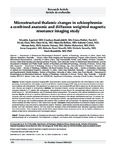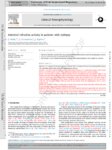|
|
Creator | Title | Description | Subject | Date |
| 1 |
 |
Foster, Norman L. | Justifying reimbursement for Alzheimers diagnostics and treatments: Seeking alignment on evidence | The increasing cost of health care combined with expensive new drugs and diagnostics is leading to more frequent gaps between regulatory and reimbursement approval decisions. As a result, persons with Alzheimer's disease may have difficulty accessing the benefits of medical advances. In contrast to ... | | 2014-01-01 |
| 2 |
 |
Agarwal, Nivedita | Microstructural thalamic changes in schizophrenia: a combined anatomic and diffusion weighted magnetic resonance imaging study | Objective: Several magnetic resonance imaging (MRI) and postmortem studies have supported the role of the thalamus in the pathophysiology of schizophrenia. Interestingly, a recent small diffusion weighted imaging (DWI) study showed abnormal thalamic microstructure in patients with schizophrenia. The... | | 2008-01-01 |
| 3 |
 |
Digre, Kathleen B. | Significance of CT and MR findings in sphenoid sinus disease. | Disorders of the paranasal sinuses, particularly the sphenoid sinus, can be associated with significant disorders of the optic and other cranial nerves. We examined 100 consecutive routine CT scans, 100 posterior fossa CT scans, and 100 MR scans to look for evidence of sinus disease, especially of t... | Sphenoid Sinus; Vision Disorders; Paranasal Sinus Diseases; Magnetic Resonance Imaging | 1989-05 |
| 4 |
 |
Bernstein, Paul S.; Zabriskie, Norman A.; Zhang, Kang; Leppert, Mark F. | Diverse macular dystrophy phenotype caused by a novel complex mutation in the ELOVL4 gene | PURPOSE: A 5-bp deletion in ELOVL4, a photoreceptor-specific gene, has been associated with autosomal dominant (ad) macular dystrophy phenotypes in five related families, in which phenotypes range from Stargardt-like macular dystrophy (STGD3; Mendelian Inheritance in Man 600110) to pattern dystrophy... | Linkage (Genetics); Middle Older people; Phenotype | 2001 |
| 5 |
 |
Foster, Norman L. | Novel insertional presenilin 1 mutation causing Alzheimer disease with spastic paraparesis. | A four-generation pedigree exhibiting early-onset autosomal dominant Alzheimer disease (AD) with spastic paraplegia, dystonia, and dysarthria due to a novel 6-nucleotide insertional mutation in exon 3 of the presenilin 1 gene (PS1) is described. Serial examinations, PET scans, and autopsy revealed t... | Older people, 80 and over; Membrane Proteins; Neuropsychological Tests | 2004-05-25 |
| 6 |
 |
Smith, A. Gordon; Singleton, J. Robinson | Lifestyle intervention for pre-diabetic neuropathy. | OBJECTIVE: The purpose of this study was to evaluate intraepidermal nerve fiber density (IENFD) as a sensitive measure of neuropathy change in patients with neuropathy associated with impaired glucose tolerance (IGT) receiving lifestyle intervention based on that used in the Diabetes Prevention Prog... | Older people; Biopsy; Blood Pressure; Body Mass Index; Cholesterol; Diabetic Diet | 2006-06-29 |
| 7 |
 |
Levy, James A. | Context-specific memory and apolipoprotein E (ApoE) epsilon 4: cognitive evidence from the NIMH prospective study of risk for Alzheimer's disease. | The aim of the study was to determine whether the epsilon 4 allele of the apolipoprotein E (ApoE) gene was associated primarily with context-specific memory among individuals at genetic risk for developing Alzheimer's disease. The effect of ApoE status on comprehensive neuropsychological results was... | Alleles; Apolipoprotein E4; Mental Status Schedule | 2004-05-10 |
| 8 |
 |
Digre, Kathleen B.; Couldwell, William T.; Amini, Amin | Photophobia in a blind patient: An alternate visual pathway. Case report. | Photophobia is a common neurological and ophthalmological symptom that has been associated with a growing number of neurosurgical conditions, especially compressive lesions. The exact signaling pathways and neurophysiological features of the disorder are not well understood; however, data from multi... | Photophobia, Blindness, Signaling Pathway, Pretectal Nuclei, Trigeminal Pathway | 2006-12-14 |
| 9 |
 |
Digre, Kathleen B. | Serum vitamin A concentration is elevated in idiopathic intracranial hypertension. | OBJECTIVE: The primary purpose was to investigate whether serum vitamin A concentration is associated with idiopathic intracranial hypertension (IIH). The secondary aim was to obtain pilot data regarding the amount of vitamin A ingested by patients and controls. BACKGROUND: Vitamin A is an attractiv... | Vitamin A; Retinol; Idiopathic intracranial hypertension; Chromatography | 2007-02-01 |
| 10 |
 |
Digre, Kathleen B. | Selective MR imaging approach for evaluation of patients with Horner's syndrome. | PURPOSE: To assess the usefulness of MR in the evaluation of patients with Horner's syndrome. PATIENTS AND METHODS: We prospectively performed MR imaging in 33 patients with Horner's syndrome (13 preganglionic and 20 postganglionic) using a protocol specifically designed for pre- and postganglionic ... | Horner Syndrome; Magnetic Resonance Imaging; Epidemiology | 1992-01 |
| 11 |
 |
Digre, Kathleen B.; Skuster, Denise Z. | Neurologic conditions presenting as psychiatric disorders. | Understanding underlying neuroanatomic function helps physicians to localize defects and search for treatable neurologic conditions. Neurologic conditions such as Huntington's chorea, Wilson's disease, Gille de la Tourette syndrome, brain tumors, encephalitis and meningitis, neurodegenerative condit... | Psychiatric Diagnosis; Neurologic Disease | 1992-06-15 |
| 12 |
 |
Kriesel, John D.; Baringer, J R; Spruance, Spotswood L. | Correlation between detection of herpes simplex virus in oral secretions by PCR and susceptibility to experimental UV radiation-induced herpes labialis. | We examined the oral secretions of 25 patients for herpes simplex virus (HSV) at the time of and following experimental UV radiation (UVR). HSV was detected in one or more oral secretion specimens in 5 of 12 (42%) cases by cell culture and in 8 of 12 (67%) cases by PCR. On the day of UVR, HSV was de... | Polymerase Chain Reaction; Ultraviolet Rays; Simplexvirus | 1994 |
| 13 |
 |
Rodin, Ernst A. | Interictal infraslow activity in patients with epilepsy | Objective: To evaluate if interictal infraslow activity (ISA), as obtained from a conventional EEG system, can contribute information about the epileptogenic process. Methods: The entire long-term intracranial monitoring sessions of 12 consecutive patients were evaluated on an XLTEK system for ISA. ... | | 2014-01-01 |
| 14 |
 |
Digre, Kathleen B.; Schmidt, Richard H.; Osborne, Anne G.; Patel, Bhupendra C.; Pratt, David; Rietz, Lisa A. | Compressive optic neuropathy caused by renal osteodystrophy. Case report. | Compressive optic neuropathy with acute or chronic vision loss has been associated with various skull base tumors, aneurysms, Graves disease, trauma, and, less commonly, fibrous dysplasia and osteopetrosis. The Author's present a case of acute visual deterioration in a 25-year-old woman who had mass... | Optic Neuropathy; Optic Nerve Decompression; Renal Osteodystrophy | 2001-10 |
| 15 |
 |
Digre, Kathleen B. | CT and hemifacial spasm. | Forty-six patients with typical hemifacial spasm had CT. Thirty-eight (83%) were abnormal, including two with surgically documented tumors. Thirty-six had a characteristic dolichoectatic vertebrobasilar artery, with the convexity pointing to the side of the spasm in 92% of the scans. This study sugg... | Hemifacial spasms; Tumors; Dolichoectiatic vertebrobasilar artery | 1988-07 |
| 16 |
 |
Bernstein, Paul S.; Leppert, Mark F. | Genotype-phenotype analysis of ABCR variants in macular degeneration probands and siblings | PURPOSE: Single-copy variants of the autosomal recessive Stargardt disease (STGD1) gene ABCR (ABCA4) have been shown to confer enhanced susceptibility to age-related macular degeneration (AMD). To investigate the role of ABCR alleles in AMD further, genotype-phenotype analysis was performed on sibli... | DNA Mutational Analysis; Nuclear Family; Phenotype | 2002 |
| 17 |
 |
Agarwal, Nivedita | Brain function monitoring during off-pump cardiac surgery: a case report | Background: Early postoperative stroke is an adverse syndrome after coronary bypass surgery. This report focuses on overcoming of cerebral ischemia as a result of haemodynamic instability during heart enucleation in off-pump procedure. Case presentation: A 67 year old male patient, Caucasian race, ... | | 2008 |
| 18 |
 |
Kriesel, John D.; Maulden, Sarah Annamarie; Spruance, Spotswood L. | Anti-interleukin-6 antibodies inhibit herpes simplex virus reactivation. | Herpes simplex viruses (HSVs) infect epithelial cells, become localized in neurons, and can reactivate in response to a variety of stimuli, including ultraviolet light and hyperthermia. The sequence of gene activation during viral replication is known, but the molecular linkage between exogenous sti... | Mice, Inbred BALB C; Tumor Necrosis Factor-alpha; Virus Activation | 1997 |
| 19 |
 |
Digre, Kathleen B.; Blumenthal, Deborah T.; Salzman, Karen L.; Jensen, Randy L.; Dunson, William A. | Early pathologic findings and long-term improvement in anti-Ma2-associated encephalitis. | A 67-year-old man sequentially developed anti-Ma2-associated paraneoplastic encephalitis (PNE) and contralateral herpes simplex encephalitis (HSE). Brain biopsy 1 month before HSE revealed extensive infiltrates of T cells, B cells, and plasma cells. Most T cells expressed the cytotoxic granule-assoc... | Paraneoplastic neurologic disorders; Encephalitis; Neoplasm;Herpes Simplex | 2006-07-11 |
| 20 |
 |
Jones, Bryan W.; Jones, Christopher R.; Czajkowski, Laura | Familial advanced sleep-phase syndrome: a short-period circadian rhythmvariant in humans | Biological circadian clocks oscillate with an approximately 24-hour period, are ubiquitous, and presumably confer a selective advantage by anticipating the transitions between day and night. The circadian rhythms of sleep, melatonin secretion and body core temperature are thought to be generated by ... | Activity Cycles; Matched-Pair Analysis; Polysomnography | 1999 |
| 21 |
 |
Digre, Kathleen B.; Gouw, Launce G.; Harris, Catherine P.; Haines, John H.; Ptacek, L.J. | Autosomal dominant cerebellar ataxia with retinal degeneration: clinical, neuropathologic, and genetic analysis of a large kindred. | The autosomal dominant cerebellar ataxias (ADCA) comprise a heterogeneous group of neurologic disorders characterized by degeneration of the cerebellum, spinal cord, and brainstem. Genetic analysis has revealed two loci, SCA1 on chromosome 6p, and SCA2 on chromosome 12q, responsible for some ADCA. W... | Retinal Degeneration; Cerebellar Ataxia; Genetic Analysis | 1994-08 |
| 22 |
 |
Digre, Kathleen B.; Kleinschmidt, Julia J.; Hanover, Rita | Idiopathic intracranial hypertension. Relationship to depression, anxiety, and quality of life | OBJECTIVE: To explore the incidence of depression and anxiety and to measure quality of life in women with idiopathic intracranial hypertension (IIH), a matched group cross-sectional study was conducted. Women with IIH (n = 28) were compared with control groups of weight- and age-matched women not d... | Intracranial Hypertension; Depression; Anxiety; Quality of Life | 2000-01-25 |
| 23 |
 |
Varner, Michael W.; Digre, Kathleen B. | Pseudotumor cerebri and pregnancy. | Pseudotumor cerebri (PTC) is most commonly seen in obese women of reproductive age. We studied 109 women with PTC between ages 16 and 44 years. In 11, PTC started during pregnancy. Thirteen women with previous diagnosis of PTC, including two of the aforementioned 11, had an additional 17 documented ... | Pregnancy Complications; Pseudotumor Cerebri; Vision disorders; Headache; Intracranial Pressure | 1984-06 |
| 24 |
 |
Swallow, Charles E.; Tsuruda, Jay S.; Digre, Kathleen B.; Glaser, Matthew J.; Davidson, H. Christian; Harnsberger, H. Ric | Terson syndrome: CT evaluation in 12 patients. | PURPOSE: Terson syndrome may be overlooked in the acute setting and often requires ophthalmologic intervention to prevent long-term visual loss. In this syndrome, vitreous or retinal hemorrhage results from an abrupt rise in intracranial pressure, leading to retinal venous hypertension and intraocul... | Retinal Hemorrhage; Visual Acuity; Vitreous Hemorrhage | 1998-04 |
| 25 |
 |
Jaeckle, Kurt A.; Digre, Kathleen B.; Jones, Christopher R.; Bailey, Peter L. | Central neurogenic hyperventilation: pharmacologic intervention with morphine sulfate and correlative analysis of respiratory, sleep, and ocular motor dysfunction. | Central neurogenic hyperventilation (CNH), for which there is no effective therapy, can eventually result in respiratory fatigue and death. This report describes a patient with CNH due to a brainstem anaplastic astrocytoma who also exhibited disturbances of sleep and ocular motor function. The CNH r... | Central Neurogenic H yperventilation; Ocular Motor Dysfunction | 1990-11 |

























